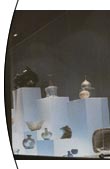Glass of The Islamic Period (11th Century AD)
Sparkles From The Deep
Glass of The Islamic Period (11th Century AD)

The
most important collection of Islamic glassware is the one that was recovered
from the Marmaris Serçe Limanı shipwreck and is on display in a special hall in
The Bodrum Museum of Underwater Archaeology. The artifacts, recovered during
excavations in 1977-1979, indicate that the ship had embarked for the Black Sea
from a port on the coast of Syria, before sinking for unknown reasons in Serçe
Limanı.
The three tons of trading cargo included glass ingots, glass fragments and
various types of glassware. There are at least 200 different types of glassware
in this collection. The mold-cast glass sences (weights) imprinted with the
names of the Fatimid Caliphs, provided documentation for the fact that the ship
started its journey in the first half of the 11th century AD.
Glassware from the Serçe Limanı shipwreck is separated into four main groups.
The first group is dinnerware, and includes large dinner plates, pitchers, fruit
dishes, bowls, cups, and goblets. The second is containers for liquids, such as
jars, bottles and demijohns. The third group consists of oil-lamps for lighting
purposes. The final group is memorial items, such as perfume bottles, inkwells
and pilgrims bottle.
Most of glass is thin-walled and made from clear, light and dark green,
yellow, pink-beige and burgundy-colored glass by free-blowing or mold-blowing
methods. The mold-blown glassware is mostly plates, bowls, and jars that
featured a repeating diamond-shaped pattern baklava pattern, with a star motif
in the center of each diamond. The free-blown glassware had cut-glass
decorations; they were luxury items and were specially made. A new technique
known as hot-cutting, was introduced during this period. Decorations were etched
on the molten glass with a sharp edge. With this technique, raised relief scenes
could be created, and more clear lines could be drawn. Motifs such as the lion
and the fishbone were introduced, along with other designs that reflected the
influence of the East and of Islam. The etchings of scenes from nature and
architecture on pitchers and cups bring to mind the enchanting atmosphere of the
Tales of the Thousand and One Arabian Nights.
The glassware, dinnerware, oil-lamps and gift bottles produced to meet the
demands of the market and scraps were transported to workshops and stores along
the Black Sea, in the towns and along the rivers.